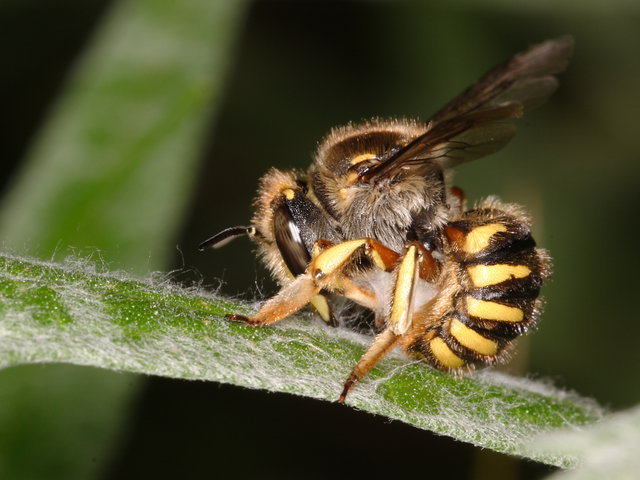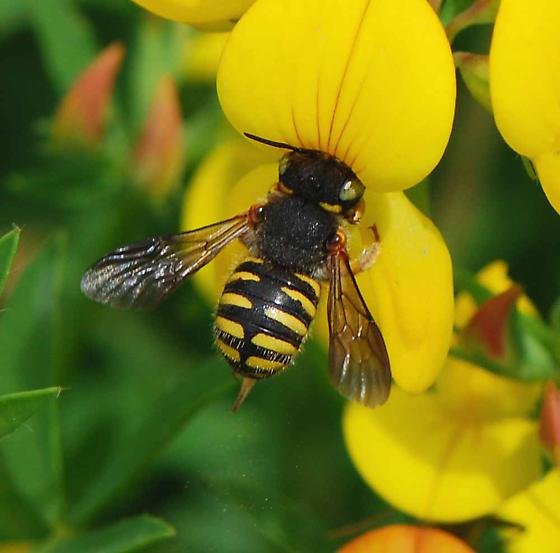Michigan insects in the garden – Season 2 Week 6: Wool carder bees
A territorial, fuzzy, non-native bee.

Few bees are easily identified to species on a plant. The wool carder bee (Anthidium manicatum) is one of them. With alternating yellow spots on its head, thorax and abdomen, and a very fuzzy underside of its abdomen, this bee is one-of-a-kind (Photo 1). This pollinator prefers to visit plants with fuzzy foliage such as lamb’s ear (Stachys), oregano, cosmos and the weedy mullein. Females scrape the fuzzy foliage of these leaves for nest construction (Photo 2).
Adult wool carder bees are solitary with a single female per nest. This wool carder bee belongs to the same family as leafcutter bees (Megachilidae) and builds a nest in rotting wood or can take residence in bee hotels. If you are considering purchasing or building a bee condo, Michigan State University Extension has a guide on caring for this structure.

A non-native but wild pollinator
The wool carder bee is native to Europe, parts of Western Asia and North Africa. First detected in New York in the 1960s, it is now widespread throughout the United States. Its entry was likely an accident, having arrived in its larval stage in wood or plant stems. A. manicatum was first detected in Michigan, near the Ohio border, in 2001, and is now widespread across most of Michigan’s Lower Peninsula. By the late 2000s, the wool carder bee had spread across much of the continental United States with reports from the Pacific Northwest and California.
A second non-native closely related bee species, Anthidium oblongatum, was also found in several Michigan counties in 2010. Both species appear similar with the main difference being an orange color in the tegula, the spot where the wings meet the insect body (Photo 3).

The wool carder bees’ success at spreading across Michigan and North America so quickly likely owes to its generalist feeding habits and its acceptance of weeds, such as chicory, that are present on roadsides. Urban and suburban gardens typically include a mix of native and non-native ornamental plants. This also contributes to an area’s ability to support pollinators who are originally from locations outside of North America. One study of New York City gardens reported that as much as 27% of bee species collected were not native to the region. Similarly, in southeast Michigan, gardens in more urbanized areas were associated with more non-native bees.
While non-native species are typically thought of as pests and detrimental to the garden, the wool carder bee is a mixed story. It can compete with native bees for resources but it is also a beneficial pollinator.
What type of risk does the wool carder bee pose to native bees?
These territorial pollinators guard the flowers they forage on very closely in preparation of a female arriving for nectar. When females land on guarded flowers, the male wool carder bee will attempt to mate with her. Males will aggressively defend their territory, sometimes chasing away other bees from flowers. They will even try to exclude larger bumble bees, but this does not impact the bumble bees’ reproductive or foraging abilities.
While there are occasional reports of wool carder bees attacking honey bees, there is no threat to population levels of honey bees or other wild bee species. At worst, the male wool carder bee is a bully who protects a particular area of flowers in anticipation of females arriving.
No control should be taken to eradicate this species. Since males do not have a stinger, humans have nothing to worry about beyond a bee that will buzz near you when approached.



 Print
Print Email
Email





